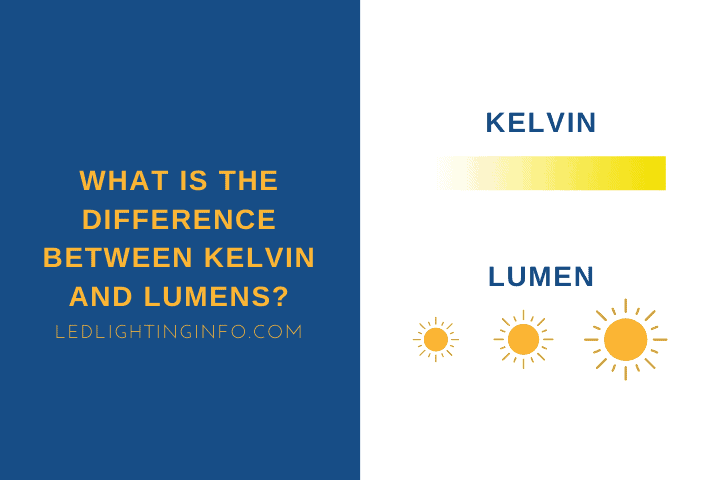Kelvins, lumens, watts, lux, CRI, beam angle, voltage, shape, base… Welcome to the world of LEDs! If you’re ready to upgrade your traditional light bulbs, prepare to be faced with a lot of specialist jargon.
While terms such as ‘Kelvin’ and ‘lumen’ are intended to provide valuable information about a light source, in reality, they make matters much more confusing.
Luckily, I’ve been in your position, and now I’m here to help!
Kelvins (K) are the units that measure the color temperature of a light source i.e., the color of white light it emits. Lumens (lm), whereas, measure the total light output of a luminaire. These two measures are completely independent and do not correlate.
When shopping for a new light bulb, there are lots of things to bear in mind. Before you become overwhelmed and consider giving up, keep reading to the end of this article.
In this post, I’m going to demystify the terms ‘Kelvin’ and ‘lumen’. More specifically, I’ll be talking about what they are, why they’re important, and whether they’re linked. Enjoy!
Lumens Explained

Let’s start with lumens, which are often denoted as lm. In simple terms, lumens are a measure of how much visible light a luminaire produces.
I’m sure many of you will be used to measuring the brightness of a bulb in watts. With traditional light sources, if you wanted a brighter bulb, you bought one with a higher wattage. But the development of LEDs means that this yardstick is no longer accurate.
This is because LEDs can produce the same level of brightness as traditional bulbs using much less wattage. For example, to produce 1600 lumens of light, you’d need a 100-watt incandescent bulb or an LED of approximately 15-watts.
Therefore, the most accurate measure of brightness is lumens. Watts, whereas, refers to the energy consumption of a luminaire.
The higher the number of lumens, the brighter a light source will be. Conversely, the lower the number of lumens, the dimmer a light source will be.
Now that you understand the basics, let’s look at where lumens derive from.
The lumens’ measurement is based on the candela (cd), which is the unit for visible light in the International System of Units (SI). Scientists noticed that one lumen is equal to one candela of light emitted uniformly across a steradian’s solid angle.
Nowadays, both terms are used to describe the luminous efficacy of light sources. While lumens refer to the total amount of light emitted, candela refers to the amount of light emitted in a particular direction.
What Is Kelvin Temperature

Next, let’s look at Kelvin’s. Kelvins, often abbreviated as K, are the units that measure the color temperature of a light source.
You see, there is no such thing as perfect white light. Lots of lights may appear to come close, but in reality, they contain an unbalanced mix of colors. Therefore, Kelvin color temperature is used to describe the warmth or coolness of light sources that fall under the umbrella term ‘white.’
The Kelvin scale was first introduced in 1848 by a British physician, Lord Kelvin. It relates to the color changes of heated metal.
When a piece of metal (often referred to as a black body radiator) is heated, the color of light emits changes as the temperature increases. At first, the light will be a warm red color. As the temperature increases, this will gradually change to orange, yellow, white, and then blue.
Numerically speaking, the scale runs from 0K to 10,000K. However, most commercially available light sources fall within the region of 2,000K to 7,000K. As a general reference, candlelight is around 2,000K, and natural daylight is around 6,500K.
Nevertheless, the confusing thing about the Kelvin scale is that it works oppositely to degrees Celsius and Fahrenheit. That is, the light gets cooler as you move up the scale. Warm, orange-toned light has a low Kelvin rating and cool, blue-toned light has a high Kelvin rating.
In simple terms, Kelvin temperature is not a measure of light output or physical heat. Instead, it governs the color temperature of a light source.
Is There Any Correlation Between Lumens and Kelvin?
A common misconception that I often read online is that cool, blue-toned lights have higher lumen outputs than yellow-toned lights.
Let me set the records straight… this is NOT true! The bottom line is that there is no correlation between lumen output and Kelvin temperature.
It is possible to have bulbs with high color temperature and low lumen output. Likewise, it is possible to have bulbs with a low color temperature and high lumen output.
No two bulbs are the same. It is even possible to have two bulbs with the same lumen outputs but vastly different color temperatures.
Don’t believe me?
Just look at these Sunco bulbs on Amazon. All have lumen outputs of 450lm, but you can choose between Kelvin ratings between 6,500K and 2,700K a.k.a daylight and soft white.
This is the great thing about LEDs, they’re entirely customizable to your needs and preferences.
Related: What Is The Difference Between Lumen and Lux?
What Is More Important When Selecting A Bulb?
Now that you understand the difference between lumens and Kelvins, you may be wondering which to prioritize when purchasing a new LED bulb.
Well, there is no straightforward answer – it depends on your individual requirements. Where will the new bulb be located? What will you be using the light for?
It’s worth reiterating that the great thing about LEDs is that the market is hugely oversaturated. Essentially, this means it’s possible to find bulbs that fit your exact lumen output and Kelvin color temperature requirements without having to make sacrifices.
Both parameters are equally as important. Let’s say that you’re installing the LED under an overhead kitchen cupboard as task lighting.
In this scenario, high lumen output is crucial because you need to see what you’re doing. You wouldn’t want to risk chopping your fingers off!
Similarly, it’s important to have a bulb with a mid-level color temperature around 5,000K to 6,000K. This will allow you to accurately see the colors of your food so you can judge its readiness.
It’s easy to assume that the brightness (lumen output) of a bulb is everything. But the impact of Kelvin color temperature cannot be overlooked.
To summarise, cool, blue-toned light suppresses the production of melatonin, which regulates sleep-wake cycles. Ultimately, this means that blue light makes you feel more awake and alert.
This is perfect for places where you need to concentrate, such as offices, schools, and kitchens. But blue light should be avoided in areas of relaxation, such as the bedroom and living room.
Final Words
That’s all there is to it! In essence, lumen output refers to the brightness of a bulb. In contrast, Kelvin temperature refers to the color of white light.
Interestingly, research shows that people from warmer climates prefer cooler light, and people from colder climates prefer warmer color temperatures.
Did you know that lumen output and Kelvin temperature have no correlation?
Which do you think is more important when selecting a new bulb?
Let’s chat, leave a message in the comments section below.
Looking for an LED bulb but not sure what type you need?
Check out my free bulb picker and select the right bulb within few clicks.


Comments are closed.